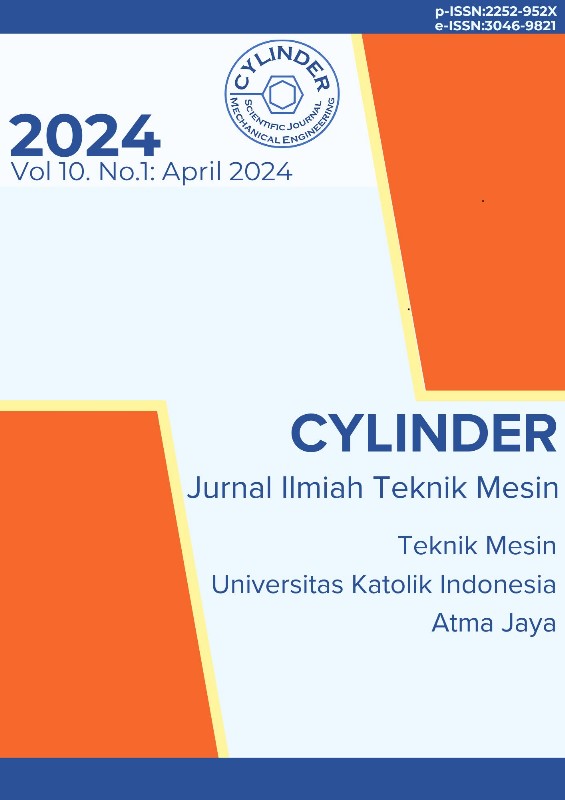Friction Stir Welding pada Paduan Aluminium 6061 dan HDPE menggunakan Mesin Frais
DOI:
https://doi.org/10.25170/cylinder.v10i1.5497Keywords:
Aluminum alloy , Polymer, Solid phase welding, Welding parameter, Friction stir weldingAbstract
Friction stir welding (FSW) is a solid-state welding method that is very simple, cheap, and in principle only requires equipment to rotate the tool and move the workpiece translationally. In this research, it was demonstrated that the FSW process of aluminum alloy 6061 and high-density polyethylene (HDPE) polymer is possible using a vertical milling machine, however, modifications need to be made to make it possible to regulate the pressure applied by the milling machine through the tool shoulder to the surface of the workpiece. Apart from that, it was also known that for each material undergoing the FSW process, it is necessary to determine the right parameter set which is a combination of rotational speed and tool feed speed to obtain optimal welding results. Too high a tool rotation speed can cause high lifting forces which can produce large porosity in the workpiece. For the HDPE FSW process, too high a tool rotation speed, which is not balanced with the increase in feed speed will provide excessive heat, causing depressions on the surface of the nugget zone.
References
M. Lipińska, “Microstructure and mechanical properties of the joints from coarse- and ultrafine-grained Al-Mg-Si alloy obtained via friction stir welding,” Materials, vol. 16, issue 18, no. 6287, 2023, pp. 1–13, doi: 10.3390/ma16186287.
M. Sarkari Khorrami, M. Kazeminezhad and A.H. Kokabi, “”Microstructure evolutions after friction stir welding of severely deformed aluminum sheets,” Materials & Design, vol. 40, 2012, pp. 364-372, doi: https://doi.org/10.1016/j.matdes.2012.04.016.
Y.S. Sato, Y. Kurihara, S.H.C. Park, H. Kokawa and N. Tsuji, “Friction stir welding of ultrafine grained Al alloy 1100 produced by accumulative roll-bonding,” Scripta Materialia, vol. 50, issue 1, 2004, pp. 57-60, doi: https://doi.org/10.1016/j.scriptamat.2003.09.037.
D.G. Mohan and C. Wu, “A review on friction stir welding of steels,” Chin. J. Mech. Eng., vol. 34, no. 137, pp. 1–29, 2021, doi: https://doi.org/10.1186/s10033-021-00655-3.
Y. Huang, X. Meng, Y. Xie, L. Wan, Z. Lv, J. Cao and J. Feng, “Friction stir welding/processing of polymers and polymer matrix composites,” Composites Part A: Applied Science and Manufacturing, vol. 105, pp. 235–257, 2018, doi: https://doi.org/10.1016/j.compositesa.2017.12.005.
Thyssenkrupp, Material data sheet: Aluminium Alloy EN AW-6061, 2018.
R.H. Stevens, ASM Handbook Volume 9: Metallography and Microstructures, ASM International, 2004.
W.M. Thomas, I.M. Norris, D.G. Staines, P.J. Clarke and N.L. Horrex, “Friction stir welding – variants and process techniques,” The First International Conference ‘Joining of Aluminium Structures’, Moscow, Russian, pp. 1–15, December 3-5, 2007.
K. Krasnowski, P. Sedek, M. Łomozik and A. Pietras, “Impact of selected FSW process parameters on mechanical properties of 6082-T6 aluminium alloy butt joints,” Archives 0f Metallurgy and Materials, vol. 56, issue 4, pp. 965–973, 2011, doi: 10.2478/v10172-011-0106-9.
S. Pavol, B. Martin and Z. Peter, “Properties of FSW and MIG welded joints of AlSiMg alluminium alloy,” Journal of Mechanical Engineering, vol 70, no. 2, pp. 141–152, 2020, doi: 10.2478/scjme-2020-0027.
Downloads
Published
How to Cite
License
Copyright (c) 2024 Cylinder : Jurnal Ilmiah Teknik Mesin

This work is licensed under a Creative Commons Attribution 4.0 International License.

